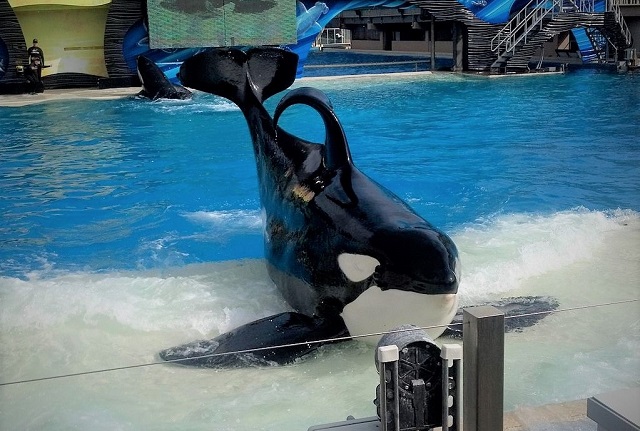Ulises: His World Upside Down

By Christina Colvin
Currently the oldest male orca living at a marine entertainment park, Ulises can be recognized by his dorsal fin, which droops in a fish-hook shape toward the right side of his body. At 19.5 feet long and 9,570 pounds, he has been living in a concrete tank for 38 years.
Ulises was born in the Atlantic Ocean off the coast of Iceland, and he spent the first three years of his life living in the ocean with his family. Then, in 1980, he was captured and shipped to the Barcelona Zoo, where he would spend the next 13 years without the company of any other orcas. It was a punishing experience for a member of such a highly social species of mammal.
In his early days at the zoo, he was bullied by the bottlenose dolphins who shared his tank. Then, as he grew larger, reports surfaced that he was acting aggressively and abnormally: mouthing the feet of people in his pool, chewing on his tongue, and chasing a female dolphin. According to former SeaWorld trainer John Hargrove, Ulises once grabbed the head of a diver who was cleaning his pool and dragged him to the surface.
In 1994, Ulises was flown from Spain to SeaWorld San Diego, where he resides to this day.
Floating listlessly for extended periods and spending time swimming upside down.
His large size in relation to the small display tank makes Ulises a spectacle for paying park visitors. But he has had more than one incident of severe aggression toward trainers both in and out of the water, resulting in official corporate incident reports. Indeed, Ulises was considered one of the most dangerous whales to interact with in the water. Only the most experienced trainers were allowed to swim with him and, according to Hargrove, one of them has said she believes Ulises would have killed her on one occasion had she not been able to get out of the pool in time.
(After the orca Tilikum killed one of the trainers at SeaWorld Orlando, the Occupational Safety and Health Administration ordered the company not to allow trainers in the orca tanks.)
 Ulises has also been aggressive toward Corky, a whale who was also captured at an early age – in her case from the waters of British Columbia. Corky and Ulises have never been compatible socially, to the point where he once bit a chunk out of her tail flukes, resulting in a near-fatal infection. Hargrove says that during his time at SeaWorld San Diego, there was a protocol in place that the two were never to be allowed contact unless Kasatka, the dominant female of the group, was also in the environment. Kasatka reportedly prevented Ulises from hurting or chasing Corky, but she died in 2017.
Ulises has also been aggressive toward Corky, a whale who was also captured at an early age – in her case from the waters of British Columbia. Corky and Ulises have never been compatible socially, to the point where he once bit a chunk out of her tail flukes, resulting in a near-fatal infection. Hargrove says that during his time at SeaWorld San Diego, there was a protocol in place that the two were never to be allowed contact unless Kasatka, the dominant female of the group, was also in the environment. Kasatka reportedly prevented Ulises from hurting or chasing Corky, but she died in 2017.
As with other male orcas used in the company’s sperm-harvesting efforts, Ulises was trained to ejaculate on command. According to SeaWorld, he sired a calf with Kalia through artificial insemination when she was eight years old, an unnaturally young age for orcas to become pregnant.
(Hargrove, who worked with Ulises during his prime sexual years, is skeptical of this story. He says that Ulises’ samples were, in fact, deemed not viable by senior SeaWorld veterinarians, and he believes that Kalia was made pregnant by her brother Nakai.)
Ulises has been viewed floating listlessly for extended periods and spending time swimming upside down. We hope he’ll have a chance, before too long, to be at a seaside sanctuary where he’ll prefer to view his world the right way up.